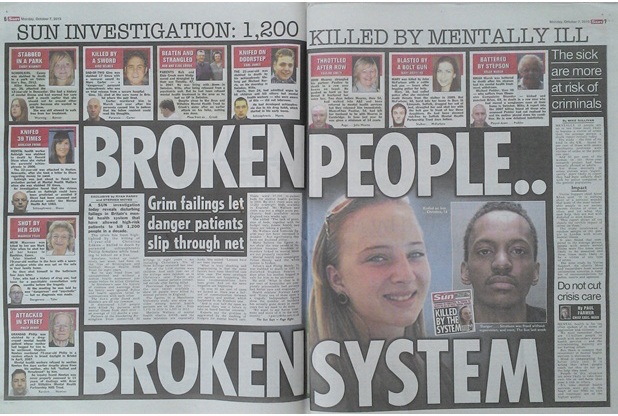
A new cross-sectional study published in the British Journal of Psychiatry has assessed the prevalence of violent victimisation amongst a group of people with severe mental illness, in comparison to a control group (Khalifeh et al, 2015).
Being a victim of crime, whether violent or non-violent, is associated with important longer term health consequences across domains (Resnick et al, 1997). In particular, victimisation is understood to drive worse clinical and functional outcomes in people with established mental illness.
In the general population, risk of victimisation is usually understood to be influenced by sociodemographic risk factors, as well as the characteristics of neighbourhoods in which people live (Brennan et al, 2010; Zedner, 2002).
Clinical experience indicates that victimisation is common among people with mental illness, particularly among those receiving intensive or longer term service contact, who are sometime defined as suffering from “serious mental illness”, or SMI, by health services.
A small number of studies have demonstrated very high prevalences of victimisation in populations with serious mental illness. For example, a 2003 study described a prevalence for violent victimization of 16% among a sample of patients with psychotic disorder (Walsh et al, 2003). However, few studies have compared these estimates with a control sample from the same underlying population as the cases.
This BJPsych study assessed the sociodemographic characteristics of victimised individuals with SMI, and compared it with a series of non-SMI controls.

Neighbourhood characteristics and sociodemographic factors influence risk of victimisation in the general population.
Method
This report compared two surveys:
- The cases: a cross-sectional survey of patients with mental health services, and
- The controls: a national crime survey of the general population.
For the patient survey, caseload lists of patients receiving key work by community mental health team (CMHT) clinicians were randomly sampled to identify the study population. These people were then asked to participate in the study, recruited and then interviewed about their experiences of crime.
Participants were all adults in care for one year or longer, and resident in the community (not in residential care). The participants had to speak English, provide capable consent, and be available for interview.

Survey data was compared between patients in mental health services and the general population from the national crime survey.
Results
1,099 patients were randomly selected from CMHT lists. 63% were eligible, of whom 52% agreed to take part. The odds ratio for case-control status for the victim of any crime was 2.8 in favour of the cases. Of note, only personal acquisitive crime was not significantly raised among cases compared to controls.
In the evaluation of acts of violence, the investigators found more violent victimisation in the cases than the controls in both men and women, but the elevated risk in women was much greater.

The study found that women with severe mental illness are at greater risk of violent crime than men.
Conclusions
The prevalence of victimisation in people with SMI was 40% compared with 14% in the control group. The relative excess of victimisation in SMI was particularly pronounced for females. This excess in victimisation reports was only partially accounted for by deprivation, drug use, and perpetrated violence.
Patients were five times more likely to be victims of assault, and three times more likely to be victims of household acquisitive crime. The likelihood of reporting violent victimisation to the police was similar between patients and controls.

Compared to controls, service users with severe mental illness are 5 times more likely to be victims of assault.
Strengths and limitations
The authors are explicit about the limitations of the study, and the conclusions are modest. Comparisons of victimisation rates in SMI with a relevant control group are rare; this study was relatively large, and appears to have been designed with this particular study objective in mind.
The response rate was very low (nearly half of people asked to participate chose not to), but any bias introduced by this probably led the estimates of excess victimisation prevalence to be less, not more pronounced. The investigators conclusions would be unlikely to have changed had this bias not been there.
The researchers could have collected some basic characteristics of non-responders from care coordinators (e.g age, gender) in order to assess whether non-responders were very different from responders. The role of neighbourhood characteristics, which are known to consistently influence the likelihood that you are victimised (Sampson et al, 1993), was not directly measured or assessed, as the researchers investigated the questions within a single study area. The effect of area of residence on the risk of victimisation in people with SMI remains an open question.
In conclusion, this study is important. People with SMI in London are at ongoing elevated risk of harm from other people, and it’s likely that there is an urgent unmet need within the NHS mental health service user population.
Although the findings are unsurprising, it is very clear that researchers have tended to focus on mental illnesses as driving the perpetration of violence, rather than investigating why SMI populations report so much violence at the hands of other patients, and the community at large.
More descriptive data, more detailed time measurement of violence exposures, and richer measurement of the experiences of patients with SMI is crucial to developing interventions to reduce violence in these people, and to evaluate and implement them effectively.

Tabloid reporting of mental illness and violence has historically focused on service users with SMI being perpetrators and not victims of crime.
Links
Khalifeh H, Johnson SC, Howard LM, et al. (2015) Violent and non-violent crime against adults with severe mental illness. British Journal of Psychiatry 2015:1-8 doi: 10.1192/bjp.bp.114.147843 [published Online First: Epub Date]
Resnick HS, Acierno R, Kilpatrick DG. (1997) Health impact of interpersonal violence. 2: Medical and mental health outcomes. Behav Med 1997;23(2):65-78 doi: 10.1080/08964289709596730 [First page preview]
Brennan IR, Moore SC, Shepherd JP. (2010) Risk factors for violent victimisation and injury from Six years of the british crime survey. International Review of Victimology 2010;17(2):209-29
Zedner L. (2002) Victims. The Oxford handbook of criminology 2002:419-56
Walsh E, Moran P, Scott C, et al. (2003) Prevalence of violent victimisation in severe mental illness. The British journal of psychiatry : the journal of mental science 2003;183:233-8
Sampson RJ, Lauritsen JL. (1993) Violent Victimization and Offending: Individual-, Situational-, and Community-Level Risk Factors. Understanding and Preventing Violence: Social influences 1993;3:1

RT @Mental_Elf: People with severe mental illness are more likely to be victims of violent and non-violent crime http://t.co/D9CtGtvTR2
People with severe mental illness are more likely to be victims of violent and non-violent crime: Vishal Bhavs… http://t.co/3MrstfsXbN
“People with severe mental illness are more likely to be victims of violent and non-violent crime” http://t.co/z3rnHHFvEe
@Mental_Elf thanks very much for another excellent blog!
@soniajohnson @Mental_Elf based on an important piece of research Sonia
Nicola Davies liked this on Facebook.
RT @UCLPsychiatry: People with mental health problems at high risk of being victims of crime – @mentalelf on new @uclpsychiatry study http:…
Rachel Gilberthorpe liked this on Facebook.
Sam Wyatt liked this on Facebook.
Today @DrVishalBhavsar on new study of violent & non-violent crime against adults with severe mental illness http://t.co/D9CtGtvTR2
Lauren Davis liked this on Facebook.
June Dunnett liked this on Facebook.
@Mental_Elf its a shame this doesn’t get the media coverage it should!
The Mental Elf liked this on Facebook.
New research finds that service users with severe mental illness are 5 times more likely to be victims of assault http://t.co/D9CtGtvTR2
RT @Mental_Elf: Today @DrVishalBhavsar study of violent & non-violent crime against adults with severe mental illness http://t.co/Kw75ZqXq9m
RT @Mental_Elf: How do the neighbourhoods we live in & sociodemographic factors affect our risk of being victimised? http://t.co/D9CtGtvTR2…
High risks of being a victim of crime among mental health service users – new @mentalelf blog on @drhkhalifeh paper http://t.co/nMXcR21kCW
People with severe mental illness are more likely to be victims of violent and non-violent crime http://t.co/OM1ijJKUZm via @sharethis
Victimisation of people with severe mental illness #mentalhealth #stigma http://t.co/Yc3cn7sqTe
Victimisation of people with severe mental illness http://t.co/ey8QNnDTEe
Rosemary Callahan liked this on Facebook.
RT @Mental_Elf: Why do newspapers focus on ppl w/ severe mental illness as perpetrators, not victims of crime? http://t.co/D9CtGtvTR2 http:…
RT @Mental_Elf: Don’t miss: People with severe mental illness are more likely to be victims of violent & non-violent crime http://t.co/D9Ct…
Sue Ord liked this on Facebook.
Kathryn Self liked this on Facebook.
Victimisation of people with severe mental illness http://t.co/VePIEFRFwD via @Instapaper
Abigail Orléans Lindsay liked this on Facebook.
“Victimisation of people with severe mental illness” via @Mental_Elf http://t.co/Ko2YIjpt82
Most popular blog this week? @DrVishalBhavsar on violent & non-violent crime against adults w/ severe mental illness http://t.co/D9CtGtvTR2
It is incredibly important that you have identified the factors associated with psychosis . Have you done some research about iatrogenic injuries by doctors receiving mental health treatment and the trauma that it causes to patients?